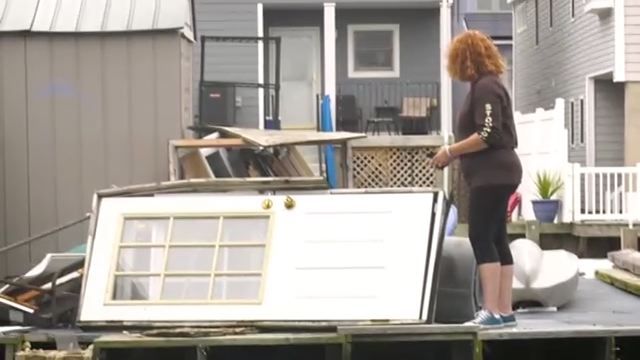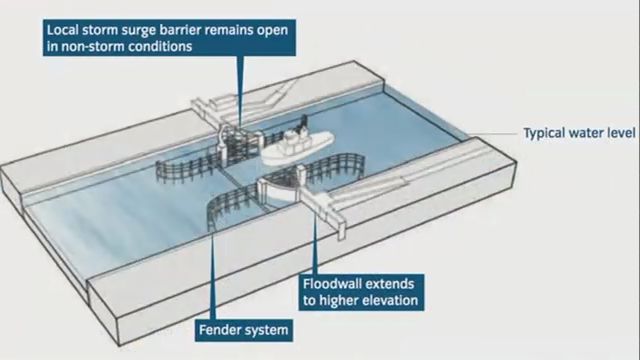Scientists say it's not if, but when, another weather emergency lands in New York. So, is the city prepared? To answer that question, we turn not just to experts and officials, but to one Manhattan resident, with experience in being stranded in a storm. NY1's Josh Robin has the story in his series, "Sandy: Five Years Later."
"This is where I live," says Melba Torres, as she enters her living space.
It is home for Melba Torres. It is also a place that can trap her.
"It felt like the world was coming to an end," she said.
That's what happened when Hurricane Sandy hit, as floodwaters surged around her East Village public housing building, the Jacob Riis Houses.
"It was pitch-dark, the wind was gusting like nothing," she recalled.
But her building's elevators were out even before the storm hit, and she says the police refused to carry her down eight flights of stairs.
But even if she had found a way, the evacuation bus wasn't equipped for people in wheelchairs.
Torres has Cerebral palsy. Concerned about electricity, she stayed in bed, praying and taking notes.
"It started to dawn on me that nobody was going to come," Torres said.
She had no power or running water. She was stranded in her apartment for six days.
"We've learned a lot from Sandy," said Joseph Esposito, the city's emergency management commissioner.
He says city has come a long way since 2012 for all New Yorkers.
It has simulated its response again and again, looking at what it did right and wrong.
"We had the evacuation — I think maybe we could have pushed that harder," Esposito says. "You had 43 deaths during Sandy. The vast majority of those people would not have died if they would have listened to the evacuation orders."
The evacuation zones have changed since Sandy, reflecting better weather knowledge. It was also identified by letters; now it's numbers, which officials hope will add clarity and urgency.
Sometimes, encouraging people to leave comes subtly. Food, for instance, was a volunteer-driven and often chaotic five years ago for those who hadn't fled.
Now, the city isn't just bumping up its warehoused human supplies for shelters; it's also added pet food to entice people to leave.
"We have food for snakes, we have food for all different kinds of animals," Esposito said. "And cages, leashes."
And remember the gasoline lines? Officials say they would do something different: ration sooner.
More than 70 gas stations now have permanent backup generators, and about 180 stations have quick generator hookups.
And after cell service died, there are mobile cell towers as well, although officials can't say how many.
Congress also just unanimously passed a bill from Sen. Charles Schumer, requiring networks to cross-honor during emergencies.
As for cooperation with other agencies, city emergency management is in "constant contact" with FEMA.
But there are also holes in readiness.
FEMA has yet to approve some stackable trailers, which are tailored to provide post-disaster homes in cities like New York, where open space is scarce.
After short-term housing, the units would start to arrive — three to six months after a disaster. And then they could last a year or even longer, with each family in one unit.
When we took a look inside one, we could see, compared to a lot of New York City apartments, it was actually very spacious and light.
There was a sleeping area that combines with a living room. There was a kitchen, using an electric stove. There were three bedrooms in the unit we checked out, all sharing one bathroom.
NY1 talked with Esposito in mid-September as Hurricane Jose threatened New York.
Robin: Do you feel comfortable that it would be better than it was previously?
Esposito: Oh, without a doubt.
Robin: What makes you say that?
Esposito: Every time we have an incident — whether it's a minor water main break, or a hurricane like Sandy — we do an after action report [on] what did we do right — which is very important — and what did we do wrong.
What do outside experts say? They're more pessimistic.
Rae Zimmerman and Bud Griffis, both of New York University, study New York's emergency preparedness.
After Sandy, Griffis led a blue-ribbon state commission to better prepare New York for future storms.
We asked them to rate preparedness, on a scale of one to ten, with ten being fully prepared.
Griffis: 4 to 5
Zimmerman: 6, 7
"I think they're actually making steps in the right direction," Zimmerman said. "It's just that the question is, Will it all be in place when the next storm comes?"
Griffis said, for one, power will go out.
"I think that it's going to cause, if not the same amount damage, at least a large percentage of the same damage," he said.
But a major reason for their middling numbers? Plans for disabled, especially, are inadequate. An estimated 11 percent of the city is disabled.
"The problem with people with disabilities is getting them to the transportation, getting them down out of their apartments," Griffis said. "Once the elevators go in a high-rise building, you're just about stuck."
That is precisely what happened to Melba Torres.
On the sixth day, Torres was able to leave her apartment. The elevator had finally started working. Two weeks later, she joined a class action lawsuit against the city alleging discrimination against disabled New Yorkers.
In a little-noticed decision, a federal judge found that the city violated federal and local law "by failing to provide people with disabilities meaningful access to its emergency preparedness program."
Particularly, there were inadequate high-rise evacuation and transportation plans.
The judge ordered both sides to come up with new procedures.
But this summer, a disability rights group wrote, "the parties have reached an impasse."
While the city says it's retrofitting them, only 24 of 64 evacuation centers are accessible.
Officials also gave NY1 confusing information about whether they could even quickly identify apartments where disabled New Yorkers live.
"We now have a daily roster that is updated every evening, as to the limited mobility residents, the residents that have medication that requires refrigeration," said Shola Olatoye, the chair and CEO of the New York City Housing Authority. "We share that with our colleagues at the Office of Emergency Management."
Robin: Do you have manifests? Do you know where these folks live?
Esposito: We're putting together lists. There's a lot of different lists out there. A lot of different agencies have lists. We're in the process right now of trying to make one master list so that we'll have a real comprehensive list of people who will need special care.
Esposito adds that declaring an emergency could help.
But Torres still is trying to warn the city, and she's getting some attention, such as from Mayor Bill de Blasio.
But to her, that's still not enough.
Torres: I don't think we're any better than we were then.
Robin: Why?
Torres: Because I quite frankly don't see any of the things that should be in place.









